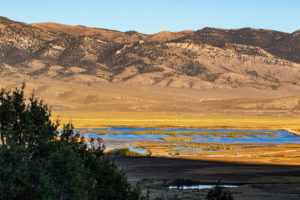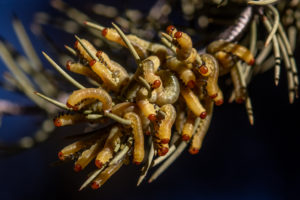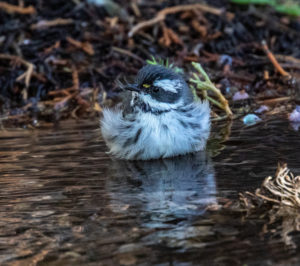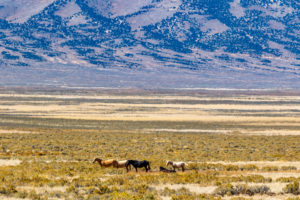
We were ready for some warmer weather and surprised how little we had to travel to get out of the cold. Lamoille Canyon is sort of a natural ice box and upon completing the 12-mile drive out of the canyon, we were back into welcoming heat. After replenishing our fresh foods at a crossroads market, we headed toward Jiggs, NV, and passed through the Harrison Pass to Ruby Lake National Wildlife Refuge. The road was graded gravel (to be expected in these remote parts), and we were saddened to see thousands of acres of scorched rangeland due to a fire earlier this summer. This fire differed from Lamoille Canyon since there were far fewer trees, and the blaze toasted mostly rabbit brush—their charred remains looking like a forest of burnt incense sticks. Northern Nevada is full of surprises—not all sad—and we keep hearing of more. While on a hike we visited with some locals from Elko, NV, who thought if we liked Lamoille Canyon, we’re going to LOVE Jarbige.
“Yep, just like Garbige (sic) but swap out the G for a J and you’ve got Jarbige.” (Note: his spelling, not mine). “Just a bunch of retired folks riding around on 4-wheelers but the scenery is terrific. Don’t miss it.” He went on to say that one way to get there is heading north on a graded road from Wells, NV, but suggested dropping down from Idaho. So we’ve added it to our next best places to visit.

An hour after Jiggs and we arrived at Ruby Lake National Wildlife Refuge and were astonished at its size. We’d learned during our visit to Sheldon NWR that it was the second largest refuge in the nation. Well, we’d just arrived at the LARGEST one. After replenishing our fresh water and a friendly visit with the Ranger at the visitor center, we set up camp just south of the fish hatchery at the South Ruby Lake CG, a National Forest campground that was practically empty. Our afternoon cocktail lounge was right behind our trailer in the shadow of Pinyon Pines and overlooking the sun setting on the Refuge.

Here and there we spotted clusters of Pinyon Bark Beetle larvae and we found them eerily fascinating as they bobbed about on their hind legs while decimating the the single-needle clusters at the tip of a branch. I asked several Rangers for more information, and one quickly snorted, “Did you kill ’em?” Evidently they’re no fan of the Pinyon Pine forests and while we saw signs of how they wreck havoc in isolated cases, I’m going to defer on capital punishment should we see more.

One morning Sooney discovered a seepage from the fresh water tank uphill from camp, and hung out for a spell enjoying many species of birds dropping by for a bath. It was so private and quiet the birds thought we were simply part of the decor—us enjoying our morning coffee while seated in camp chairs with binoculars (and camera) at the ready. It was protectively dark and I recall Red-breasted Nuthatches, Mountain Chickadees, Cassin’s Finches, jays, and a Hairy Woodpecker all taking turns to drop down from nearby shrubs and pines for a drink. As the sun rose, things got brighter and an adorable Black-throated Warbler appeared, jumped into a shallow pool, and splashed about for the better part of 3 minutes (an eternity compared to other bathers). Really fun to watch and far more gregarious than the other timid birds.

Our destination after a two-night stay was Great Basin National Park and getting there was an adventure. The only road heading south was graded granite and it took us a couple hours to get to Ely, NV. The only other vehicles we saw were supply trucks washboarding the road while servicing several mines seemingly in the middle of nowhere. The terrain was classic high desert with sage, more sage, and a clutch of wild mustangs just hanging out. Now and again an unidentified Sparrow would rise from a roadside shrub but for the most part if was 40+ miles that gave our trailer a pretty good shakeup. Once we connected with Hwy. 50 (“The Loneliest Highway in America”), we completed this part of our journey to Ely, NV for fuel and some provisions. To our surprise, there was a self-service car wash on our route and we jumped at the opportunity to remove a lot of road splash covering the front of our Escape.
Meanwhile, here is a list of birds Sooney compiled during this leg of the journey: White-crown Sparrows, Meadowlark 2, Wilson’s Snipes 3, Killdeer 10, Ibis 21, Great Egrets 5, Coots 100+, Ruddy Duck 2, Marsh Wren, Pelicans, Northern Harriers, Caspian Tern?, Double-crested Cormorant, Pied-billed, Mallard, Green-winged Teal, Gadwall, Barn Swallows, Tree Swallows, Mtn Bluebirds 5, Hairy Woodpecker 3, Red-breasted N 6, Cassin’s Finch 6, Nashville Warbler, Plumbeous Vireo, Owls (audible), Juniper Titmouse, Mtn Chickadee 2, Black-throated Gray, Magpie, Scrub Jay, Flicker, Kestrel, Turkey Vulture, Sparrow, Northern Harrier 2, Marsh Wren, Red-winged Blackbirds, Canada Goose 6, Song Sparrow 3, Sandhill Crane 2, Great Blue Heron 2, White-crowned Night Heron, Yellow headed Blackbird 3, Ruby Crowned Kinglet, Common Yellow, Loggerhead Shrike, Say’s Phoebe
